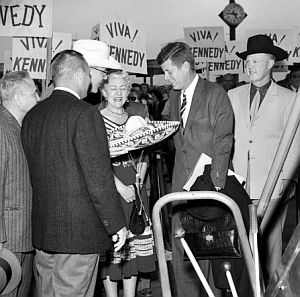Six Sigma methodology is known for its data-driven approach to process improvement. One aspect of Six Sigma that is rarely mentioned, however, is the way that it taps into a basic human need to motivate project teams and gain their loyalty.
This need is not often discussed in the world of process improvement and statistical analysis, but it is pure gold in the world of politics. It has helped many unlikely candidates upset front-runners to win elections.
In the book Hardball, political commentator Chris Matthews distills the rules of politics and how candidates use them to get elected. At the top of the list is a rule commonly used in politics – and practiced with great skill and success by John F. Kennedy.
 In his first congressional race, Kennedy needed to build a political organization, and he did so by doing one simple thing – he asked. He went door-to-door asking the hard working people of his district to volunteer their time to work on his campaign.
In his first congressional race, Kennedy needed to build a political organization, and he did so by doing one simple thing – he asked. He went door-to-door asking the hard working people of his district to volunteer their time to work on his campaign.
It worked fabulously.
During his first campaign he recruited tens of thousands of volunteers and ended up winning the election. More importantly, those volunteers became long-term loyal Kennedy backers who campaigned for him, donated money, and voted for him in future elections.
Asking for support worked so well that the Kennedy organization used it in his bid for presidency. The Kennedy campaign managers traveled the country asking minor political players, small-town mayors and county chairmen for their support in the election. No other presidential candidate was asking for help, but Kennedy did and it resulted in his winning the race in one of history’s closest U.S. presidential elections.
The Secret Is…
Successful politicians like Kennedy know a simple truth about human nature: if you want to win someone’s loyalty, don’t make a promise, ask for a favor. It sounds counter-intuitive but it’s true. As the renaissance political commentator Niccolo Machiavelli observed, the more you invest in someone or something, the more committed you become.
How Six Sigma Uses the Ask
Black Belts who practice Sigma full-time are primarily leading Six Sigma projects. However, most of the employees involved on the project have other job duties and are part-time Six Sigma participants. They contribute to the process because they were asked. As they participate in the project, they become more loyal and committed to the project and to the Six Sigma methodology.
Employees can become involved with Six Sigma by playing many different roles:
Green Belts – These employees have been trained in Six Sigma problem solving and methodology. In addition to Six Sigma training, they also provide insight into how the process works. Green Belts keep their “day jobs” and can be drawn from the ranks of operational specialists, managers, process owners and professional staff.
Yellow Belts – These rank-and-file employees receive training in Six Sigma fundamentals to help collect data, define critical process factors, use measurement scales and make simple improvements. Yellow Belts can include staff members, administrators or operations personnel.
Contributors and Participants – Participating in a Six Sigma team does not necessarily require a formal designation or belt ranking. The Six Sigma project also involves employees who contribute indirectly, including those who help collect data and provide insight into the process.
Six Sigma is widely known for reducing costs and minimizing defects using data-driven analytical tools, objective rigor and exacting statistical methods. An often overlooked benefit of Six Sigma is the loyalty that employees will naturally give to a project or the Six Sigma methodology itself – simply because they are asked to participate. Organizations, just like politicians, can get this loyalty for free and use it to help secure a successful campaign.
